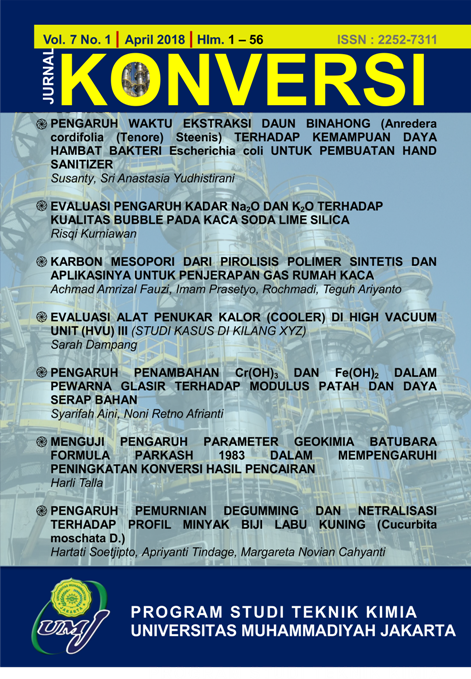EVALUASI ALAT PENUKAR KALOR (COOLER) DI HIGH VACUUM UNIT (HVU) III (STUDI KASUS DI KILANG XYZ)
Main Article Content
Abstract
HVU III is designed to process reduced crude oil from CDU V or reduced crude from export oil existing tanks. HVU III is one unit that aims to lift light fractions that may still be contained in reduced crude. The vacuum condition is designed to attract mild fractions at relatively low temperatures. With the effort to take the product slop wax as HVGO, indeed the operating condition is changing and there is addition of equipment (Pump and HE) and modification of piping. Therefore in this study about design HE (Cooler) with slop wax product as HVGO which will be cooled from temperature 298oC to 70oC with flow rate 40 m3 / hr. And as a cooling medium used Sea Water (sea water) from temperature 30oC to 38oC. Pressure slop wax 20 kg / cm2 and sea water 4 kg / cm2. The calculation results for cooling the wax slop requires a Cooler of 6 (six) units with a seawater requirement of about 709187.39 lb / hr, and heat transferred in a fouled state of 0.0029 hr ft2 F / btu. Pressure drop for slop wax equal to 7.08 psi while sea water equal to 39.33 psi. Under these conditions it is expected that the addition of equipment in this case Cooler can be done as an effort to take the product of slop wax as HVGO.
Article Details
Issue
Section
Articles
Authors who publish with this journal agree to the following terms:
- Authors retain copyright and grant the journal right of first publication with the work simultaneously licensed under a Creative Commons Attribution License that allows others to share the work with an acknowledgement of the work's authorship and initial publication in this journal.
- Authors are able to enter into separate, additional contractual arrangements for the non-exclusive distribution of the journal's published version of the work (e.g., post it to an institutional repository or publish it in a book), with an acknowledgement of its initial publication in this journal.
- Authors are permitted and encouraged to post their work online (e.g., in institutional repositories or on their website) prior to and during the submission process, as it can lead to productive exchanges, as well as earlier and greater citation of published work (See The Effect of Open Access).
